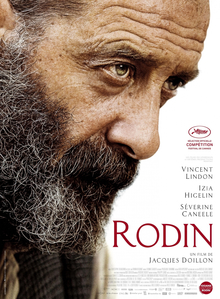
François Auguste René Rodin was a French sculptor generally considered the founder of modern sculpture. He was schooled traditionally and took a craftsman-like approach to his work. Rodin possessed a unique ability to model a complex, turbulent, and deeply pocketed surface in clay. He is known for such sculptures as The Thinker, Monument to Balzac, The Kiss, The Burghers of Calais, and The Gates of Hell.

Camille Rosalie Claudel was a French sculptor known for her figurative works in bronze and marble. She died in relative obscurity, but later gained recognition for the originality and quality of her work. The subject of several biographies and films, Claudel is well known for her sculptures including The Waltz and The Mature Age.

Camille Claudel is a 1988 French biographical drama film about the life of 19th-century sculptor Camille Claudel. The film was based on the book by Reine-Marie Paris, granddaughter of Camille's brother, the poet and diplomat Paul Claudel. It was directed by Bruno Nuytten, co-produced by Isabelle Adjani, and starred her and Gérard Depardieu. The film had a total of 2,717,136 admissions in France. Adjani was nominated for the Academy Award for Best Actress for her role, the second in her career.

The Musée Rodin of Paris, France, is an art museum that was opened in 1919, primarily dedicated to the works of the French sculptor Auguste Rodin. It has two sites: the Hôtel Biron and surrounding grounds in central Paris, as well as just outside Paris at Rodin's old home, the Villa des Brillants at Meudon, Hauts-de-Seine. The collection includes 6,600 sculptures, 8,000 drawings, 8,000 old photographs and 7,000 objets d'art. The museum receives 700,000 visitors annually.

Alfred Boucher was a French sculptor who was a mentor to Camille Claudel and a friend of Auguste Rodin.

Jessie Lipscomb, later Jessie Elborne, was an English sculptor of the human figure. She worked in Paris in a shared studio workshop in the late 1800s with French sculptor Camille Claudel and two fellow alumni from the Royal College of Art: Amy Singer and Emily Fawcett.
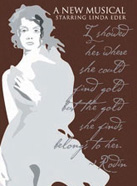
Camille Claudel is a musical with a book and lyrics by Nan Knighton and music by Frank Wildhorn, their second musical. It is based on the life of the real-life French sculptor and graphic artist Camille Claudel. The musical premiered at Goodspeed Musicals in 2003.

Monument to Balzac is a sculpture by Auguste Rodin in memory of the French novelist Honoré de Balzac. According to Rodin, the sculpture aims to portray the writer's persona rather than a physical likeness. The work was commissioned in 1891 by the Société des Gens de Lettres and a full-size plaster model was displayed in 1898 at a Salon in Champ de Mars. After coming under criticism the model was rejected by the société and Rodin moved it to his home in Meudon. On 2 July 1939 the model was cast in bronze for the first time and placed on the Boulevard du Montparnasse at the intersection with Boulevard Raspail.

The Mature Age, also named Destiny, The Path of Life or Fatality (1894–1900) is a sculpture by French artist Camille Claudel. The work was commissioned by the French government in 1895, but the commission was cancelled in 1899 before a bronze was cast. A plaster version of the sculpture was exhibited in 1899, and then cast in bronze privately in 1902. A second private bronze casting was made in 1913, and it is thought that the plaster version was destroyed at that time.

Perseus and the Gorgon is a 1902 monumental sculpture by Camille Claudel that portrays a scene from Greek mythology. The artist sculpted her own likeness for Medusa's face, in anger after the break-up of her romantic partnership with sculptor Auguste Rodin. The work achieved a great notoriety throughout the years.

Camille Claudel 1915 is a 2013 French biographical film written and directed by Bruno Dumont. The film premiered in competition at the 63rd Berlin International Film Festival.

Ottilie Helen McLarenWallace was a sculptor, a pupil of Auguste Rodin and an Associate Member of the Royal Society of British Sculptors.
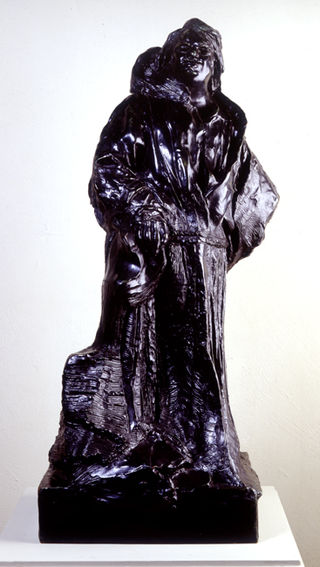
Balzac in the Robe of a Dominican Monk is a bronze sculpture by French artist Auguste Rodin, one of the studies made in preparation to the Monument to Balzac, a tribute to novelist Honoré de Balzac commissioned by the Society of Men of Letters of France in 1891.

Head of Camille Claudel is a polychrome glass paste sculpture by the French artist Auguste Rodin, conceived in 1884 and executed in 1911. It is now in the Museo Soumaya in Mexico City. It shows his then studio assistant Camille Claudel in a Phrygian cap.

The Succubus is a bronze sculpture with a green and dark brown patina. It was originally conceived in 1889 by the French artist Auguste Rodin as part of a set of works showing sirens and Nereids. It later formed part of his state-commissioned monument to Victor Hugo. It is now in the Museo Soumaya in Mexico City.
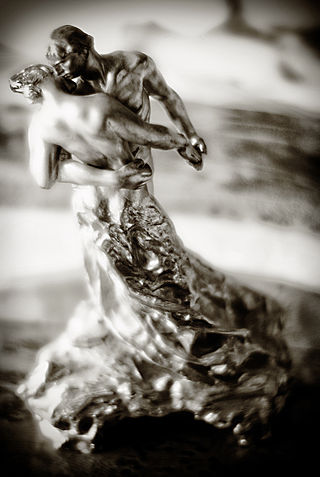
The Waltz or The Waltzers is a sculpture by French artist Camille Claudel. It depicts two figures, a man and a woman, locked in an amorous embrace as they dance a waltz. The work was inspired by Claudel's burgeoning love affair with her mentor and employer Auguste Rodin. Various versions were made from 1889 to 1905, initially modelled in plaster, and later cast in bronze. Examples are held by the Musée Rodin and the Musée Camille Claudel.

The Musée Camille Claudel is a French national museum which honors and exhibits the art of sculptor Camille Claudel. The museum displays approximately half of Claudel's existing artwork. The Claudel museum was opened in 2017 in her teenage home town of Nogent-sur-Seine, 100 kilometers southeast of Paris.

Sakuntala, also known as Sakountala or Çacountala, is a sculpture by the French artist Camille Claudel, made in several versions in different media from 1886, with a marble version completed in 1905, and bronze castings made from 1905. The sculpture depicts a young couple, with a kneeling man embracing a woman leaning towards him. It was named after the play Shakuntala by the 4th-5th century Indian poet Kālidāsa, and is inspired by the moment when the title character Shakuntala is reunited with her husband Dushyanta after a long separation.

Rose Beuret was a French seamstress and laundress, known to have been one of the muses and, for 53 years, the companion of Auguste Rodin, whom she married just weeks before her death in 1917.
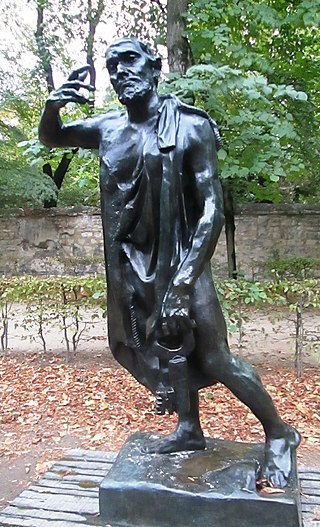
Jacques de Wissant was, together with his brother Pierre, one of the six burghers of Calais. Because of the name, it can be assumed that the brothers are from the village of the same name, Wissant, near Calais.
